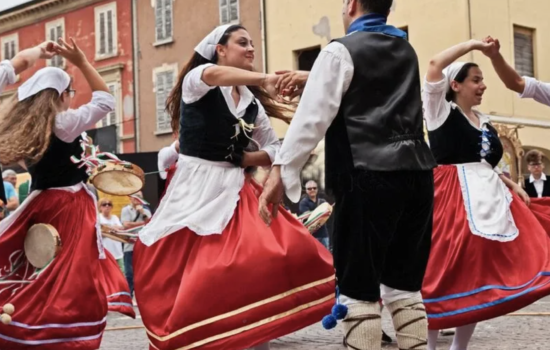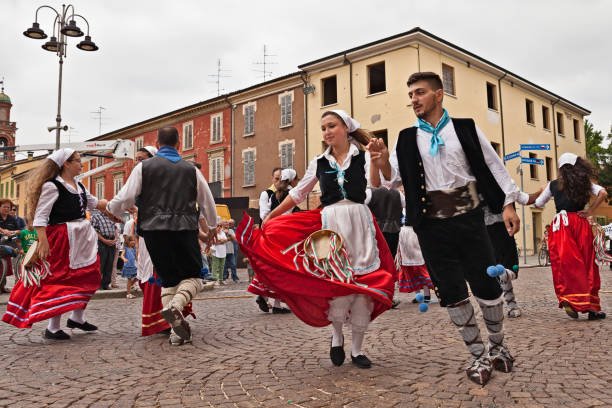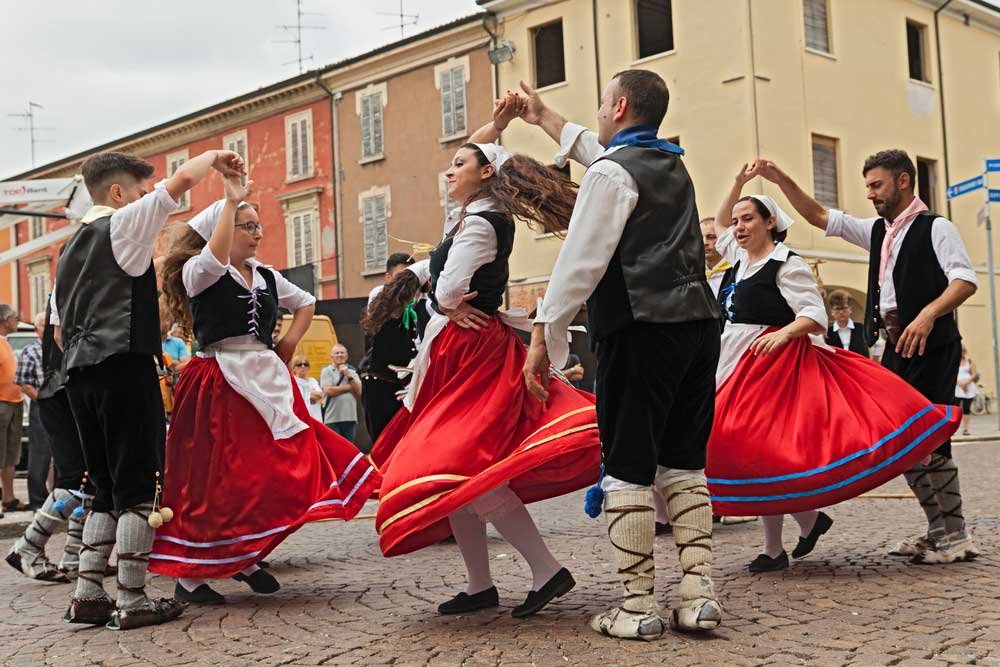Italian Traditions: Dance the Tarantella!
Throughout history, dancing has been used for an abundance of purposes, including to celebrate, uplift, worship, and even cure! Countries around the world have folk dances and music that tell stories and share insight from their rich history, and Italy is no exception. Known as the most notable of Italian folk dances is the Tarantella.
Characteristics of the Tarantella
The Tarantella is a folk dance of Italy performed by couples. It is known for lively, light, quick steps and teasing, flirtatious behavior between partners. Now, dancers will typically be clad in bright red, white, and crisp green outfits to match the powerful trifecta that represents the Italian flag.
The brisk, sweet movements of the women, together with the intoxicating beat of the tambourine they use while dancing, is said to cause much excitement in their male partners. The men’s role is to lure his partner into succumbing to his charms with tender moves and the quickness of his feet.
While the music of Tarantellas traditionally rely on instruments like a mandolin, a guitar, an accordion and tambourines, they also used flutes, fiddles, trumpets, and clarinets. Tarantellas were also written for the piano by multiple composers including Frédéric Chopin, Franz Liszt, and Carl Maria von Weber.
The Origins of the Tarantella
Before it become a courtship dance, it was known as the dance of the spider with Tarantella deriving from the Italian word “tarantola”, meaning “tarantula.” The tarantola gets its name from the town of Taranto in Puglia, where the bite of the local tarantula (known then as wolf spider) was widely believed to be highly poisonous and led to a condition known as “tarantism.”
Tarantism was a disease ad form of hysteria between the 15th and 17th centuries that swept through Taranto and other parts of Italy. According to legend, once bitten by a tarantula, the person bitten, referred to as the tarantata (who was almost always a woman of lower status) would fall into a fit in which she was plagued by heightened excitability and restlessness.
Partaking in the frenzied dancing ritual of the Tarantella was the only cure. Townspeople would surround the tarantata while musicians would play instruments such as mandolins, guitars, and tambourines in different tempos in search of the correct healing rhythm. Each varied beat would affect the tarantata, leading her to move in erratic ways in line with the tempo. Once the correct rhythm was found, the tarantata danced the Tarantella alone until exhausted which was thought to have “sweated out” the venom, curing them.
How to Dance the Tarantella
The dance itself is said to be “unlucky” to dance alone, therefore, people dance in couples or groups of couples. With multiple couples, the tarantella is a circle dance alternating from clockwise to counter-clockwise and back to clockwise as the music progresses. The dance picks up speed as it goes. With this, the dance is usually created around the music, with small steps in time to the music and hand gestures to match.
The Steps:
Facing front, cross your right foot in front of the left. Cross your left foot in front of the right. Step your right foot to the side, step your left foot to the side. Repeat this while the woman shakes the tambourine in a clockwise circle in front of her body.
Place your hands on your hips, kick the right foot out to the front keeping it low to the ground, then step on the right foot putting weight on it, slightly in front of the left foot. Touch the ball of your left foot to the ground (without putting your full weight on it) then step in place with the right foot. This sequence is called the tarantella step. Repeat this sequence beginning with a left-foot low, front kick. Repeat again beginning right, then repeat once more beginning with the left. Perform this sequence three more times, traveling backward slightly.
Face your partner. The woman hits the tambourine to her left shoulder, her left hip, then her right hip. Repeat this, making a triangle across the body. Tap the left hand twice with the tambourine. Perform the tarantella step forward twice, beginning with the right foot kick, so that your right shoulders pass each other. Dance the tarantella step twice moving backwards to return to the starting position. This back and forth sequence can be referred to as a “do-si-do.” Moving the tambourine twice as quickly, the woman taps her left shoulder then right hip. Repeat this tambourine sequence, then tap the left hand twice with the tambourine. Repeat the “do-si-do.”
The man holds the tambourine in his left hand and kneels on his right knee, tapping the tambourine for seven counts of music on his right hip. On count eight, tap it twice. The man continues to kneel for eight more counts of music. Meanwhile, the woman places her hands on her hips and dances eight tarantella steps in place.
The man remains in the kneeling position for the next 16 counts of music, but with the tambourine now shaking above his head. The woman performs eight Tarantella steps forward in a counterclockwise circle around the kneeling man.
Two couples stand opposite each other with right hands reaching center, holding hands, forming a star shape, with left hands holding the tambourines. The couples perform eight tarantella steps simultaneously, the group rotating in a circle clockwise. Clap the tambourine on the last step. Everyone turns to join left hands in the center. Perform the eight tarantella steps again, now turning in the opposite direction. Clap the tambourine on the last step.



